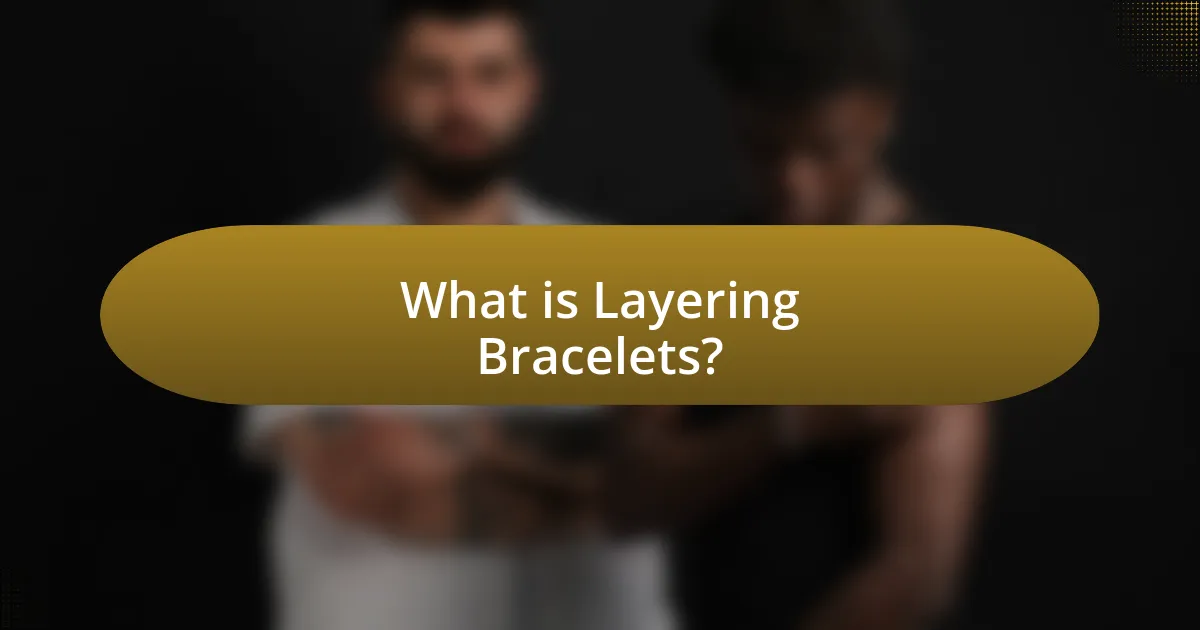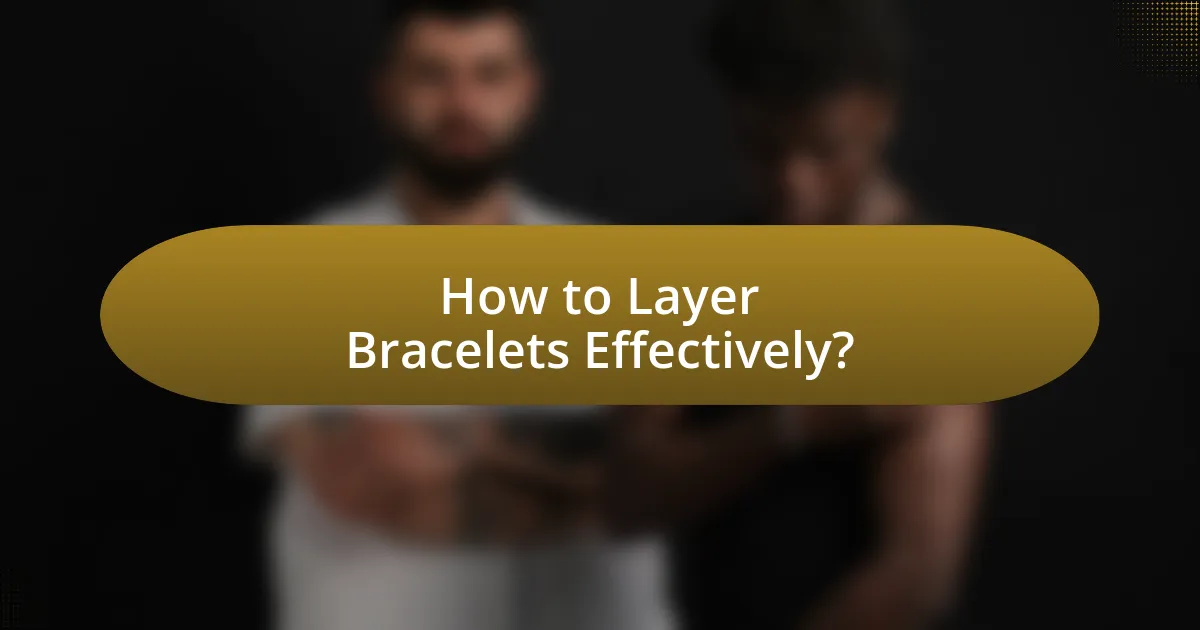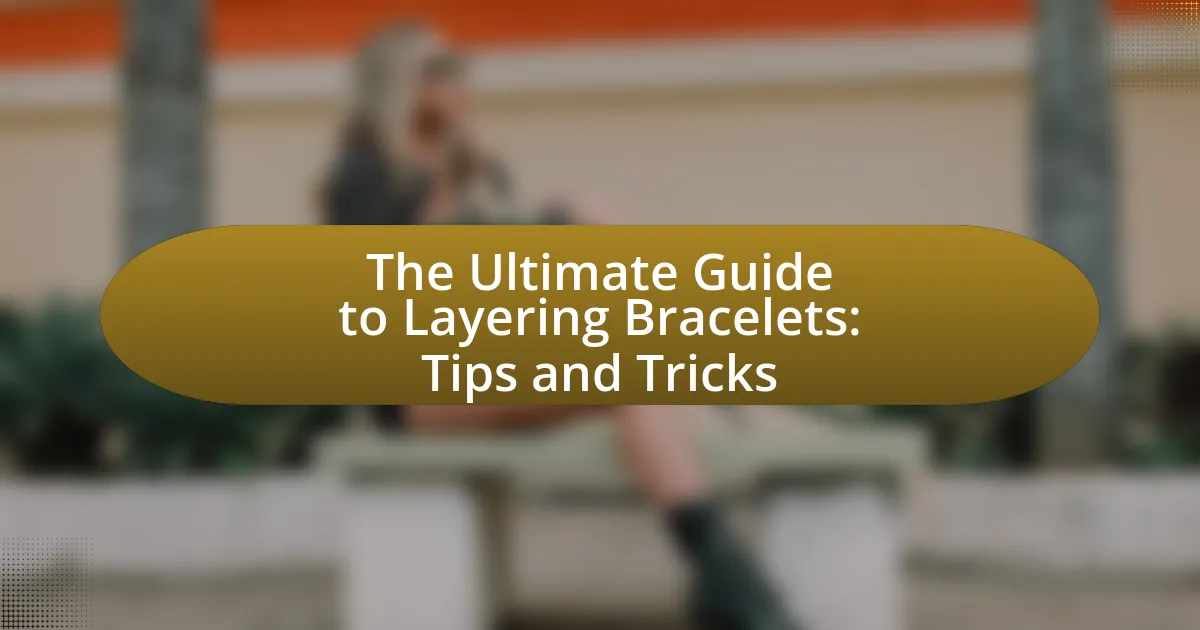Layering bracelets is a fashion trend that involves wearing multiple bracelets on one wrist to create a personalized and visually appealing style. This guide explores the origins of the trend, cultural influences, and the impact of social media on its popularity. Key elements of effective layering, such as variety in texture, balance in size, and thoughtful color coordination, are discussed, along with tips for selecting the best types of bracelets for layering. Additionally, the article covers best practices for combining casual and formal styles, troubleshooting common layering issues, and expert tips for mastering the art of bracelet layering.

What is Layering Bracelets?
Layering bracelets refers to the fashion practice of wearing multiple bracelets on one wrist simultaneously to create a visually appealing and personalized style. This trend allows individuals to mix different materials, colors, and designs, enhancing their overall look. The concept of layering has gained popularity in jewelry fashion, with many influencers and fashion enthusiasts showcasing various combinations to express individuality and creativity.
How did the trend of layering bracelets originate?
The trend of layering bracelets originated from various cultural practices and fashion movements that emphasized personal expression and individuality. Historically, different cultures, such as the ancient Egyptians and indigenous tribes, adorned themselves with multiple bracelets as symbols of status, spirituality, or protection. In modern fashion, the trend gained popularity in the early 2000s, influenced by celebrities and social media, who showcased eclectic styles that encouraged mixing and matching different types of bracelets. This shift towards layering reflects a broader movement in fashion that values uniqueness and personal storytelling through accessories.
What cultural influences have shaped the popularity of layered bracelets?
Layered bracelets have gained popularity due to various cultural influences, particularly from fashion trends in the 1960s and 1970s, where bohemian styles emphasized personal expression through accessories. The rise of social media platforms has further amplified this trend, allowing influencers and celebrities to showcase layered looks, thereby encouraging widespread adoption. Additionally, cultural practices from regions such as Africa and South America, where stacking jewelry is a traditional form of adornment, have contributed to the aesthetic appeal and acceptance of layered bracelets in contemporary fashion.
How has social media impacted the layering bracelet trend?
Social media has significantly influenced the layering bracelet trend by providing a platform for users to showcase their personal styles and inspire others. Platforms like Instagram and Pinterest allow influencers and everyday users to share images of their layered bracelet combinations, which encourages widespread adoption and creativity in styling. According to a study by the Pew Research Center, 72% of adults use social media, making it a powerful tool for trend dissemination. This visibility has led to increased demand for diverse bracelet styles, as users seek to replicate popular looks seen online.
What are the key elements of layering bracelets?
The key elements of layering bracelets include variety in texture, balance in size, and thoughtful color coordination. Variety in texture can be achieved by mixing materials such as leather, metal, and beads, which adds depth to the overall look. Balance in size is important; combining thin and chunky bracelets creates visual interest without overwhelming the wrist. Thoughtful color coordination ensures that the layered pieces complement each other, enhancing the overall aesthetic. These elements work together to create a cohesive and stylish layered bracelet look.
What types of bracelets are best for layering?
The best types of bracelets for layering include bangles, chain bracelets, and leather bracelets. Bangles are ideal due to their rigid structure, allowing them to stack easily without overlapping. Chain bracelets offer versatility in length and style, making them suitable for mixing with other materials. Leather bracelets add texture and contrast, enhancing the overall layered look. These types of bracelets are commonly used in fashion to create a personalized and stylish appearance, as layering can showcase individual style and creativity.
How do materials and textures affect the layering of bracelets?
Materials and textures significantly influence the layering of bracelets by determining their visual appeal and tactile experience. Different materials, such as metal, leather, fabric, and beads, create distinct looks and weights, which can either complement or clash when layered. For instance, a smooth metal bracelet can contrast beautifully with a textured leather piece, adding depth to the overall aesthetic. Additionally, the texture of each bracelet affects how they interact; rough textures can create visual interest and prevent slipping, while smooth textures may slide against each other, requiring careful arrangement to maintain balance. Studies in fashion design emphasize that the combination of varied materials and textures enhances the overall style, making layered bracelets more visually dynamic and personalized.
Why is layering bracelets a popular style choice?
Layering bracelets is a popular style choice because it allows individuals to express their personal style and creativity through unique combinations. This trend enhances visual interest and can reflect individual personality traits, as seen in fashion movements where layered accessories signify a bold and eclectic aesthetic. Additionally, the versatility of layering enables wearers to mix different materials, colors, and textures, creating a customized look that can be adapted for various occasions.
What personal expression does layering bracelets allow?
Layering bracelets allows individuals to express their personal style and individuality. This form of adornment enables wearers to combine different materials, colors, and designs, reflecting their unique tastes and moods. The practice of layering can also convey personal stories or significant life events through the selection of specific pieces, such as friendship bracelets or heirlooms. Additionally, the trend of stacking bracelets has been supported by fashion studies indicating that accessorizing in this manner enhances self-expression and boosts confidence, as seen in various fashion magazines and style blogs.
How can layering bracelets enhance an outfit?
Layering bracelets can enhance an outfit by adding depth and visual interest. This technique allows individuals to express their personal style through the combination of different textures, colors, and materials, creating a unique look. For instance, a study by the Fashion Institute of Technology indicates that accessorizing with layered jewelry can elevate the perceived sophistication of an outfit, making it more appealing. By strategically mixing various bracelet styles, such as bangles, cuffs, and delicate chains, wearers can achieve a balanced and cohesive aesthetic that draws attention and complements their overall attire.

How to Layer Bracelets Effectively?
To layer bracelets effectively, start by mixing different styles, materials, and widths to create visual interest. For instance, combine delicate chains with chunky bangles or leather cuffs to achieve a balanced look. Additionally, consider the color palette; using complementary or contrasting colors can enhance the overall aesthetic. According to fashion experts, layering three to five bracelets is optimal for a cohesive appearance without overwhelming the wrist. This approach allows for personal expression while maintaining a stylish and organized look.
What are the basic rules for layering bracelets?
The basic rules for layering bracelets include mixing different styles, varying the widths, and balancing colors. Mixing styles allows for a unique combination of textures and designs, while varying widths creates visual interest and depth. Balancing colors ensures that the layered look remains cohesive; for instance, pairing neutral tones with a pop of color can enhance the overall aesthetic. These principles are widely recognized in fashion guidelines, emphasizing the importance of harmony and contrast in accessory styling.
How do you choose a focal bracelet for layering?
To choose a focal bracelet for layering, select a piece that stands out in design, color, or texture to serve as the centerpiece of your layered look. A focal bracelet should complement the other bracelets in your stack while also being distinct enough to draw attention. For instance, if you choose a bold cuff bracelet, it can contrast effectively with thinner, more delicate chains or beaded bracelets, creating visual interest. The effectiveness of a focal bracelet in layering is supported by the principle of balance in design, where a single statement piece can enhance the overall aesthetic of multiple accessories worn together.
What is the importance of balance in bracelet layering?
Balance in bracelet layering is crucial for achieving a visually appealing and harmonious look. When bracelets are layered, maintaining balance ensures that the overall design does not appear cluttered or overwhelming. A well-balanced arrangement considers factors such as size, color, and texture, allowing each piece to complement rather than compete with others. For instance, pairing a chunky bracelet with thinner ones can create a dynamic yet cohesive appearance. This principle is supported by design theories that emphasize the importance of proportion and contrast in visual arts, which apply equally to fashion accessories.
How can you mix different styles of bracelets?
To mix different styles of bracelets effectively, start by selecting a cohesive color palette that ties the pieces together. This approach ensures that even if the styles vary—such as combining leather, metal, and beaded bracelets—they will still appear harmonious. Additionally, consider varying the widths and textures of the bracelets to create visual interest; for example, pairing a chunky cuff with delicate chain bracelets can add depth to your look. Layering bracelets with different materials can also enhance the overall aesthetic, as contrasting textures can create a more dynamic appearance. This method is supported by fashion experts who emphasize the importance of balance and contrast in accessory styling.
What are the best practices for combining casual and formal bracelets?
The best practices for combining casual and formal bracelets include selecting complementary styles, balancing materials, and considering color coordination. When combining these types of bracelets, choose a formal bracelet made of materials like metal or leather and pair it with a casual bracelet crafted from fabric or beads. This contrast creates visual interest while maintaining a cohesive look. Additionally, ensure that the colors of the bracelets either match or complement each other to avoid clashing. For instance, pairing a silver watch with a leather bracelet in a similar tone can enhance the overall aesthetic. These practices help achieve a stylish layered look that is appropriate for various occasions.
How do you incorporate colors and patterns in layered bracelets?
To incorporate colors and patterns in layered bracelets, select a cohesive color palette and mix different textures and designs. For instance, using complementary colors enhances visual appeal, while varying patterns, such as stripes, dots, or geometric shapes, adds depth. Research indicates that color theory supports the idea that harmonious color combinations can create a balanced look, making the overall design more attractive. By strategically combining these elements, layered bracelets can achieve a stylish and personalized aesthetic.

What Tips and Tricks Can Enhance Your Bracelet Layering?
To enhance your bracelet layering, focus on varying the textures, materials, and widths of the bracelets. This approach creates visual interest and depth in your layered look. For instance, combining leather, metal, and fabric bracelets can add contrast, while mixing thin and chunky pieces can create a balanced aesthetic. Additionally, consider the color palette; using complementary or monochromatic colors can unify the look. According to fashion experts, layering bracelets in odd numbers, such as three or five, often results in a more dynamic and appealing arrangement.
How can you personalize your bracelet layering style?
To personalize your bracelet layering style, select a combination of materials, colors, and sizes that reflect your individual taste and personality. For instance, mixing metals like gold and silver can create a unique contrast, while incorporating beads or leather can add texture. Additionally, varying the lengths of the bracelets allows for a visually appealing stack that showcases your style. Research indicates that personal expression through accessories can enhance self-identity, making your choices not just aesthetic but also meaningful.
What accessories complement layered bracelets?
Necklaces and rings complement layered bracelets effectively. Necklaces, particularly those with varying lengths and styles, can enhance the visual appeal of layered bracelets by creating a balanced look. Rings, especially stackable ones, can add to the layered effect, allowing for personal expression and style coordination. This combination is commonly seen in fashion trends, where the layering of different accessories creates a cohesive and stylish appearance.
How can you adjust your layering for different occasions?
To adjust your layering of bracelets for different occasions, select the number and style of bracelets based on the formality of the event. For casual settings, opt for a mix of colorful, textured, or beaded bracelets to create a relaxed look. In contrast, for formal occasions, choose fewer, more elegant pieces, such as metal or gemstone bracelets, to maintain sophistication. This approach is supported by fashion guidelines that suggest matching jewelry styles to the event’s dress code, ensuring that the overall appearance is cohesive and appropriate.
What common mistakes should you avoid when layering bracelets?
When layering bracelets, avoid the mistake of not considering balance and proportion. An unbalanced look can occur when bracelets of varying widths and styles are combined without thought, leading to a chaotic appearance. Additionally, neglecting to mix materials and textures can result in a monotonous look; for instance, pairing only metal bracelets can lack visual interest. Another common mistake is overcrowding the wrist, which can overwhelm the overall aesthetic; a good rule of thumb is to limit the number of bracelets to three or four for a cohesive look. Lastly, failing to consider the occasion can lead to inappropriate choices; for example, wearing overly casual bracelets to a formal event can detract from the overall outfit.
How can you troubleshoot issues with bracelet layering?
To troubleshoot issues with bracelet layering, first assess the compatibility of the bracelets in terms of size, material, and style. If bracelets are too tight or too loose, they may not layer well, causing discomfort or an unappealing look. Additionally, consider the color and texture combinations; mismatched colors or clashing textures can disrupt the overall aesthetic.
For example, wearing a chunky bracelet alongside delicate ones may create imbalance. Adjust the arrangement by placing larger pieces at the center and smaller ones on the sides to achieve a harmonious look. Lastly, if noise or tangling occurs, ensure that the clasps and chains are secure and not overlapping excessively, as this can lead to wear and tear.
What are the signs of an unbalanced bracelet layer?
Signs of an unbalanced bracelet layer include uneven spacing between bracelets, mismatched styles or colors, and disproportionate weight distribution. When bracelets are layered, they should complement each other in both aesthetics and physical balance; if one bracelet appears significantly larger or heavier than the others, it disrupts the overall harmony. Additionally, if the bracelets slide excessively or do not sit comfortably on the wrist, this indicates an imbalance. Proper layering should create a cohesive look, where each piece enhances the others without overpowering them.
What are some expert tips for mastering bracelet layering?
To master bracelet layering, start by mixing different styles and materials to create visual interest. Combining delicate chains with chunky bangles or leather cuffs adds depth to your look. Additionally, consider varying the lengths of the bracelets; wearing some higher on the wrist and others lower creates a dynamic effect. Balance is key; if you choose bold statement pieces, pair them with simpler designs to avoid overwhelming the eye. Lastly, ensure that the color palette complements your outfit; cohesive colors enhance the overall aesthetic. These strategies are supported by fashion experts who emphasize the importance of contrast and balance in accessory styling.

Leave a Reply